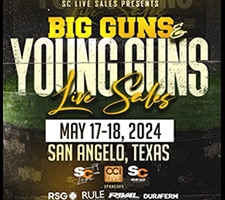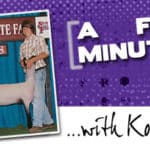
This edition of A Few Minutes is with Bart Cardwell from Oklahoma, the market judge for the Nebraska State Fair 4-H Market Lamb Show. Enjoy reading our candid interview with Mr. Bart Cardwell and be sure to check back for more state fair judge interviews! Best of luck to our Nebraska championdrive.com clients and viewers.
Why do you take the time out of your busy schedule to judge market lamb shows?Mainly because I enjoy working with and evaluating young 4-H and FFA members as well as evaluating sheep and other livestock.
What is your background and current involvement in the sheep industry?
I grew up on a diversified farm in north central Oklahoma raising crops like wheat, alfalfa, grain sorghum and forage sorghum as well as Registered Shorthorns, Duroc, Spot and Poland hogs and commercial and registered Suffolk and Hampshire sheep. I have been involved in raising show stock since I purchased my first registered Duroc gilts at the age of 10. In high school, after a Pseudo rabies quarantine on pigs in Oklahoma, I decided to get rid of my swine project and started focusing on raising Registered Suffolk breeding sheep and eventually club lambs, as the two types started to get further apart in terms of phenotype.
Currently, I am the Northern Oklahoma College (NOC) Sheep Center Herdsman in Tonkawa, OK. NOC Ag Division Chair, Dr. Kurt Campbell, and the NOC President, Dr. Joe Kinzer, offered me the opportunity to start a sheep program at its two year school in 2007. With the help of generous supporters and the flock I had at the time, we started the program. The flock consists of 125 brood ewes, consisting of Suffolks, Hampshires and Dorsets, that are selected for club lamb and slick-sheared breeding sheep (a.k.a., Tweeners) production. I teach a sheep production and management class every semester that is a comprehensive study of raising, selecting, managing and exhibiting sheep. It is a great job for a person that likes raising livestock and teaching people about that subject. I am very blessed for having that opportunity at NOC.
How does your current operation effect what you look for when evaluating sheep?
I believe every livestock production system starts with good females so I am very particular about female selection. I will not keep females that have unsound mothering and milking ability. We rarely assist ewes during lambing because of this selection. This is a two year process at NOC. When it comes to selecting females, I look at the dam first and her consistency as a producer. I usually give a female three strikes before she is culled or kept. Phenotypically, I look for sheep that are smooth fronted with a high chest floor, round in their rib shape, with a top line that is wide and square and gradually gets wider as you move back to the pins. I am very critical of how level hipped a sheep is as well. I also want sheep that are appropriate in their growth pattern and condition. Sheep also need to be sound structured on their feet and legs for me. For ram and wether selection, I want to see more of the same with as much muscle as possible without sacrificing structure.
What person/people influenced or helped to shape your view on what the ideal sheep should possess?
My dad, Phil Cardwell, Bill Crutcher, former Oklahoma State University sheep herdsman, and Vince McGolden, Ag Ed Instructor at Fairview, OK, are all people that have played an important part in influencing my opinions on sheep selection and management. All of them have the ability to see a young animal and its possibilities as a mature animal to genetically influence the herd in a positive manner.
Where did you attend college?
I attended Oklahoma State University getting a BS Double Major in Animal Science and Ag Education (‘92) and an MS in Animal Reproductive Physiology (‘97).
What are your initial sorts when evaluating market lambs?
I sort out the structurally incorrect animals, poorly muscled animals, and overly conditioned animals (wethers).
When you get down to those top end lambs, what separates them for you?
I look for balance and completeness (i.e., structurally correct in skeletal and muscular organization). They need to be adequate in length of hind saddle, growth and condition with some elevation in the chest floor.
What would you consider an acceptable fat range? .2 – .3 in.
Who are some people that you credit with helping you get to where you are today?
There is a large list. Besides the three gentlemen mentioned in #4, first of all is my wife of 19 years, Judy. Without her support when we raised sheep before the NOC opportunity came along, I would be gone during lambing season, and she would reluctantly take care of things-even with two kiddos under the age of three. She is the best supporter I have. My mother, Kay, whose love of raising livestock and spending time in the lambing barn was passed on to me. Others include producers/partners and educators like- Keith Bolenbaugh, Ron Robinson (both deceased), Larry Shell, Dr. Bill Schaefer and son Scott, Dale Goodwin, Warren Finder, Dr. Brent Pitts, Skipper Wilson, Sherry Nelson, Tommy Wilkerson (former ag ed teacher), and Jarold Callahan (former OSU Judging Coach) just to name a few.
What’s the best market lamb you have ever seen?
This is not a fair question because there have been more than one that I really liked. One of the best at a show for the times was the Cabaniss lamb Margie Mayor had in 1987 at the OKC Spring Livestock show. That was the first lamb I saw that was the total package-complete in his top line and structure, wedge-shaped top and a great look. Hooter Burchfield, Fairview, OK, had a Hurliman Natural Colored lamb that was pretty good that Brad Angus selected for grand lamb at OYE in 2003. I was also a big fan of the Skidgel ewe in the commercial division at OYE that Tyson Rule now has called the “Crip” ewe. I appreciate her even more for what she has done as a female.
Who’s the person you most like to sit down and watch judge?
I like to watch Brad Angus judge. He is smooth as silk on the mic and an excellent evaluator of the total sheep package. However, if we are talking any species, I choose Oklahoma State Animal Science Department’s Kim Brock-no one is smoother, convincing and more descriptive when evaluating swine.
What do you think is the most important issue facing the sheep industry?
Infrastructure and knowledge of the industry by both those raising sheep and consuming lamb is a huge issue, and the continued decline of sheep numbers in the USA. It seems we need to increase consumption and keep foreign lamb supplies controlled so they don’t adversely affect our domestic market share.
What’s your biggest pet peeve in the showring? Not paying attention to the animal or the judge.
Do you consider yourself more of a handle judge or a profile judge? Profile
You’ve got one night to go anywhere in the country and watch one band? Where is it and who are you watching?
The Red Rocks Amphitheatre in the Colorado Rockies to see Third Day. A Close second, same place with Jason Aldean and Blake Shelton.
Who is your favorite sports team?
Anything Oklahoma State puts on a field or a court. Go Pokes!
What is your favorite place to vacation? Colorado Rockies, particularly the San Juan’s near Ouray, CO.
Thanks Bart for your time!
















